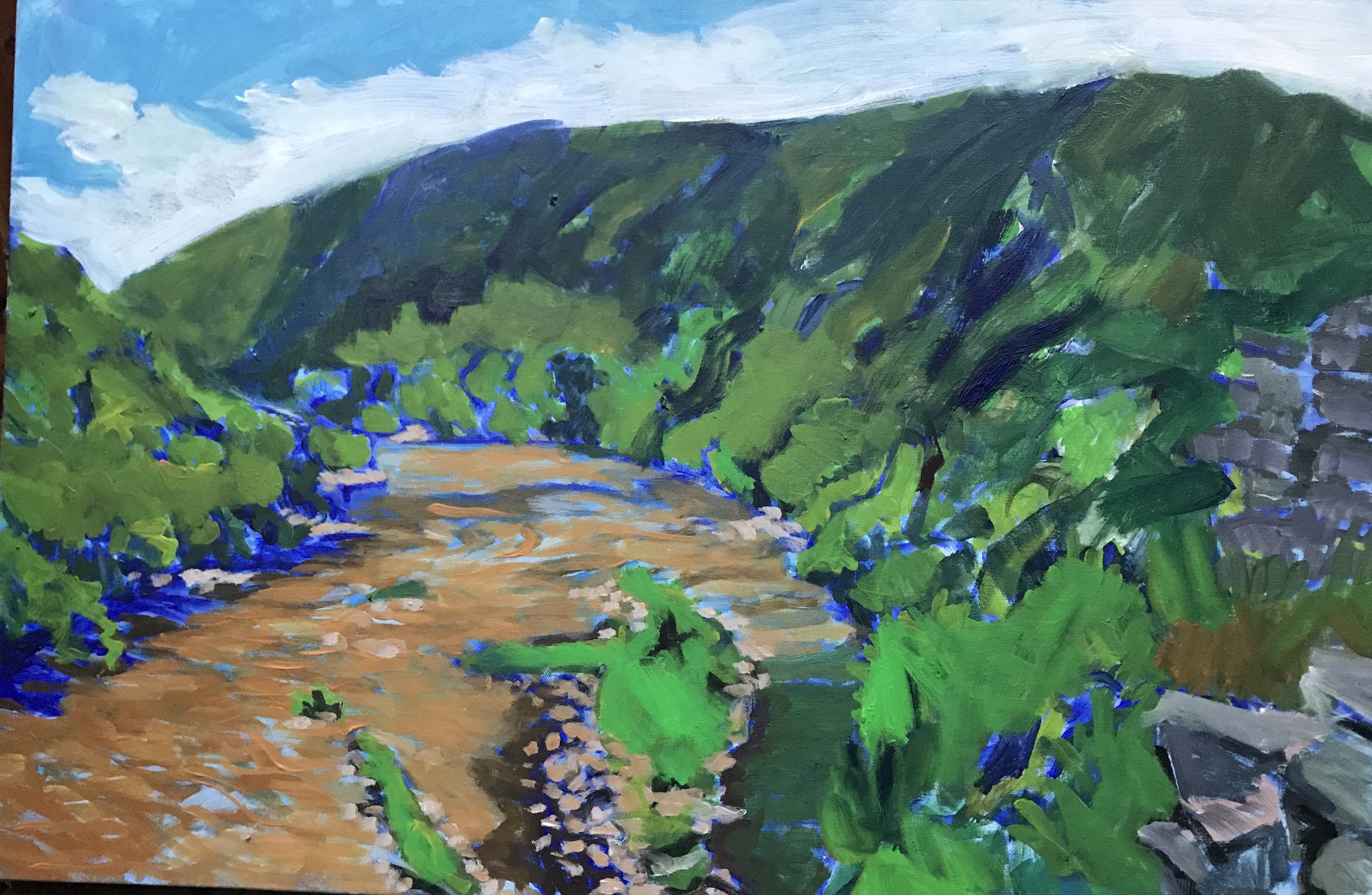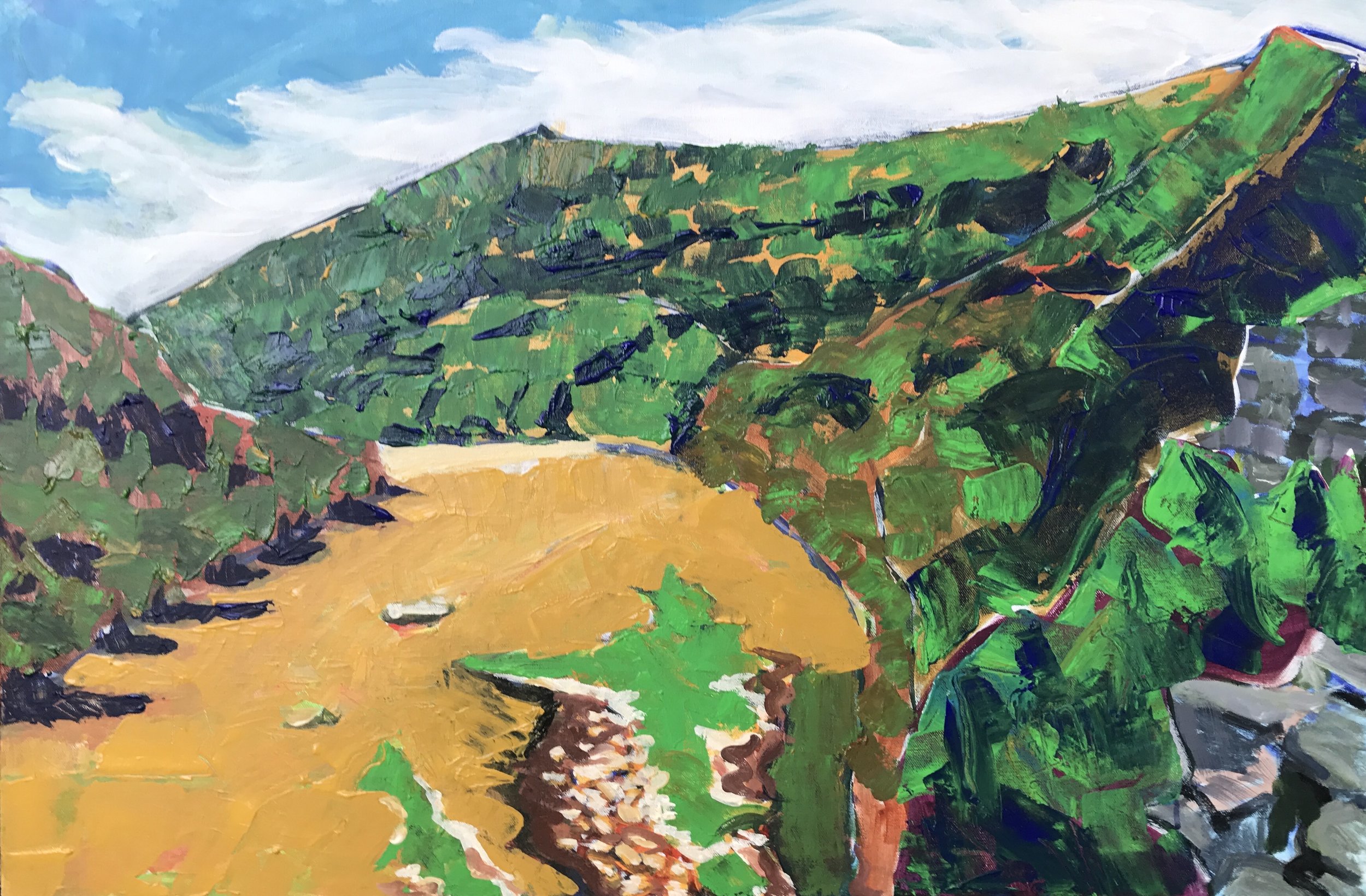Sometimes it feels like a scene paints itself. All the work seems preordained and there aren't decisions as such. It just is a matter of putting the brushstrokes and colors where the moment tells you they belong. That is a great feeling and the work done that way has a sense of organic integrity and freshness that is unbeatable. Other times seem weighted down with many problems to solve or gaps between what I can do and what I need to do. I frequently used to paint over scenes that I could not figure out how to complete. So, anyone who has one of my pieces from my twenties possibly has two or three images, one atop another. Lately, I've tried to find a way through to the end, even if it's at the expense of the freshness of the observations at the scene. It's as valuable, maybe even more so, to work through all the puzzles and try new tools as it is to quickly knock something out. It's a matter of self-discipline to find a way to get what I need to make the piece work in some manner.
This painting took me a long time to finish, mainly because I had a hard time matching the tools to the image, but also because I didn't have a clear vision of the end state of the painting, which is pretty typical for me. I started out doing a ultramarine blue underdrawing on a cerulean blue background - 24" x 36". The original drawing got the shapes and volumes of the banks of the river pretty well. This was painted on top of an overlook that required me to lug gear about a hundred feet up a very, very steep climb. To do the underdrawing, I had to leave behind everything except a brush, a tube of blue paint, some water, and the canvas. On the way up I was stung by hornets, which put a dent in the old plein air mood.
(Photo: James Tucker)
If I could have preserved anything from the original it would have been something from the first pass at the river. I really liked the transition from brown to yellow ochre to pale ochre, all on top of that blue background. This set of deep blues reminds me of some of the late Cezannes that I like enormously. It would be fun to try this another time as a night scene.
On a second visit with all the gear, I put some paint into the spaces for the trees on the mountainsides using a single brush, leaving the blue underpainting in view. Some I did in the straight green and some darkened, but the overall effect resembled piles of cabbages. I lost the thread of the drawing during this stage. I avoided the hornet's nest this time, sparing myself what would have been a brutal tumble down Paint Rock.
Continuing with the brush, I reworked the right side of the mountains to replace the cabbage with patches to suggest the contours of the slopes in some places and some prominent details of the foliage in others. In all this the colors were just me putting paint up there, not something derived from observation. I was trying to step into a space that is unfamiliar for me, a little in the spirit of John Marin, like the stabs and angles in the lower right corner. This was not a successful step. But a few things started here that survived into later states. First, I reworked the horizon to create a "V" where the two mountains meet. Second, the rock outcroppings in the foreground and middle distance persisted. Third, a few of the efforts succeeded in making the slope shapes. But, all this is done in the crudest manner. The one place I still liked was the water and the island in the lower center of the river.
Getting stuck can make you do some absurd things. My next move was to drop almost everything I had done to this point and try out some palette knife work with some odd choices for underpainting. Part of this goes back to how I painted one of my more successful views of Mt. Ste. Victoire. The other part may have come from a colored pencil workshop I did with a friend, where we used a random gouache color as a base for our drawing. I also wanted to try a flattened river surface- forget about trying to get the river to look like it's flowing. So, here's what that yielded.
I almost would have called this last stage a finished product, if I had had the nerve. I liked pieces of this painting a lot, and wanted to work more expressively with a palette knife again. But something left me unsatisfied. It seemed too spasmodic, too easy somehow. Kind of funny considering how much had gone on before. So I lived with this version for a while, but I wanted to get the tree in. It felt like the composition would be incomplete without it. I knew that would be nearly impossible given how chaotic the painting of the mountains behind the tree would be. So I began to imagine a way to keep some of the palette knife and interesting underpainting while getting the crazier parts to tone down enough to let me put the tree in. First I used a thinned out dark green wash to darken most of the right side of the mountain. I also went back in on the rock outcroppings and rendered them in a more traditional style, and from there it spread over the right side of the mountain, and down to the river and the islands. Later I picked up a Sharpie and began to add lines to the rocks and the river.
So then the character of the painting shifted increasingly to a conventional representational work. But what was curious is how many pieces of earlier stages persisted. I added more detail to the mountains, the trees, and the river. I took out the clouds and replaced them with a blue sky. At some point I remembered there was a railroad that ran behind the trees. I caught glimpses of it as I was painting up there. I added a railroad line and, above it, a road for traffic. I had a lot of fun working with the deep red browns, blues, and greens on the left side. With some additional work on the water and some Sharpie details, I brought this to an end.
This place is called Paint Rock because there were Native American hieroglyphics found here.
Here is the view from which I worked on this painting. This is another case, similar to the Wolf River painting, where, except for the tree in the foreground, I depended less and less upon a reference photo.
Over a year later I reworked much of this painting in oils. I never could reconcile myself to that yellow ochre water, even though that’s what it was. I couldn’t render it so that it registered as water instead of a creek bottom or arroyo. So, later, I went over it one more time with oils using a blue and green palette for the water. Then I reworked the island and some key parts of either bank of the river. And I lightened the tone of the sky. Here is how that ended up. I liked the reflection of the left bank in the water and the pink rocks. I also liked the distant rock outcropping after the right bank takes a turn. Right about there it changes from NC to TN. I also like the ridgeline better.










